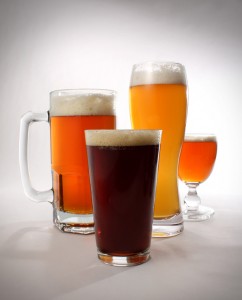GOBLET
Some are dainty, some thick-walled and robust; either way, it’s the big bowl that does the work. A wide mouth promotes deep gulps of heavy sipping beers, and the sheer largesse of the cup holds up inches-high heads.
Use with: Burly Belgians: dubbels, tripels, quads and strong ales.
Try: Dansk Hanna Goblet, about $9 each, dansk.com
WEIZEN
Soft curves and thin walls separate the weizen glass from its pilsner cousin. The height makes room for giant, fluffy heads; the voluptuous shape traps those citrusy banana smells.
Use with: Wheat beers—hefeweizens, weizenbocks and dunkelweizens—and ryes, too.
Try: Mikasa Brewmasters Collection Wheat glass, $40 for four, mikasa.com
TULIP
An exaggerated top lip gives this glass its floral name; it’s also responsible for supporting huge heads and promoting big smells.
Use with: Scotch ales, bière de gardes, fruit beers, English barleywines, strong ales, and any beer with a substantial head or strong nose.
Try: Libbey Poco Grande glass, $12 for four, libbey.com
FLUTE
Bubbles and big bouquets are best showcased in a flute glass: The long, thin body keeps carbonation alive and liberates aromas more quickly, plus, the stem lifts bright-hued beers off the table for easy admiration.
Use with: Highly carbonated, boldly colored beers like gueuzes, lambics, bocks, Flanders red ales, wild ales, saisons and, of course, bière de Champagne.
Try: Crate & Barrel Solo Port Glass, about $5 each, crateandbarrel.com
SNIFTER
Swirl rich, robust beers in a snifter; the stem and wide bowl lend to proper, tidy agitation, and the tapered mouth detains potent scents.
Use with: Heavy styles, and anything with a nose so thick you can taste it: American barleywines, strong Scotch ales and imperial styles.
Try: Riedel Napoleon Brandy Glass, $78 for two, riedel.com
PILSNER
Slim and tapered, pilsner glasses show off extreme carbonation and clear, almost shiny colors. The vessel’s ample top half keeps heads sturdy.
Use with: Pilsners, but also steam beers, light lagers, Munich helles and schwarzbiers.
Try: The Cellar Premium Krosno pilsner, about $25 for four, macys.com

MUG
Mugs are less about science and more about convenience: Made for holding profuse amounts of beer, mugs bear that classic handle, made for lifting large loads and clinking other glasses. Fun fact: a siedel is a standard mug, while a mug with a lid (added during the Black Plague to keep flies out of beer) is a stein.
Use with: Any beer drank in bulk: Oktoberfests, light lagers, pale ales, cream ales and witbiers.
Try: Anchor Hocking Gusto mug, $20 for four, anchorhocking.com
STANDARD PINT
Your standard 16-ounce tapered bar glass is an all-purpose vessel for nearly every beer style on the planet, and it’s the perfect vehicle for beers that don’t require a lot of fuss. But this glass is also ideal for hoppy pale ales and IPAs, as those styles continuously exude hop aromas—the smells don’t need to be trapped.
Use with: Mellow styles like blonde ales, cream ales, amber ales and steam beers, plus pale ales and IPAs.
Try: Williams Sonoma Classic Pint (not pictured), $51 for four, williamssonoma.com
IMPERIAL PINT
Slightly larger than a standard pint, these glasses hold an imperial pint—568mL, or about 1.2 American pints. (In fact, in the U.K., it’s illegal to sell a pint measuring any less.) The bulge near the top is constructed to accommodate frothy heads and helps make sturdy stacking.
Use with: Heady, flavor-packed pub standards like brown ales, red ales, stouts, porters and cask ales. Also the standard choice for rauchbiers, ESBs, pumpkin ales and kölsches.
Try: Libbey International Beer Glass Set imperial pint glass, $23 for four (within a 12-piece set), libbey.com
TIP: Cleanliness is godliness when it comes to serving beer: Even the tiniest amounts of soap, dust or lipstick can ruin a good pint. To keep glassware spic and span, hand-wash your set in mild dishwashing liquid; dishwashers and rinse agents can leave behind deposits that alter beer’s head and flavor. Dry using a kitchen chamois, or better yet, air-dry; towels may abandon fibers or dust on wet glass. Finally, store glasses upright in a cabinet, or top-down on mesh to allow all water to evaporate and deter mold.


Where’s the best place online to buy a couple of all these glasses?
Thanks!
Rick
We’ve noted some suggested retailers for each of the glasses above, and many of them sell several styles of glasses; some even offer beer-tasting sets with multiple styles. Check those spots first!
Can you point me to one or more that sell the sets with multiple styles?